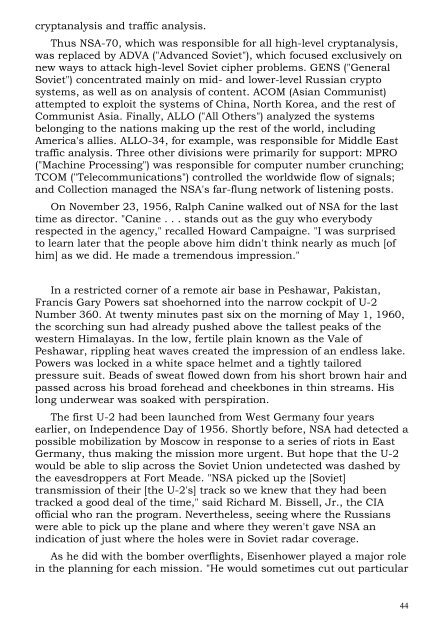- Page 2 and 3: ACCLAIM FOR JAMES BAMFORD'SBODY OF
- Page 4 and 5: FIRST ANCHOR BOOKS EDITION, APRIL 2
- Page 6 and 7: ACKNOWLEDGMENTSMy most sincere than
- Page 9: CHAPTER ONE MEMORYKVZIEBCEN CKYIECD
- Page 13 and 14: profile." Nevertheless, he gave his
- Page 15 and 16: team of American and British codebr
- Page 17 and 18: called Bletchley Park that the futu
- Page 19 and 20: Koniginpastete and the russische Ei
- Page 21 and 22: Germans had departed with such hast
- Page 23 and 24: without his knowledge," said one TI
- Page 25 and 26: intercept operators, to handle the
- Page 27 and 28: developed to divert a single signal
- Page 29 and 30: in the late forties, and later head
- Page 31 and 32: Security Agency. Odonovich commande
- Page 33 and 34: eview. The review then pointed a fi
- Page 35 and 36: CHAPTER THREE NERVESJFKH WRXSHN WRL
- Page 37: would keep his ears finely tuned fo
- Page 41: of pins to mark the hot spots. On J
- Page 46 and 47: Finally, the link from Washington t
- Page 48 and 49: closely it was held. "Intelligence
- Page 50 and 51: At the White House the sun was just
- Page 52 and 53: Secretary of State Christian Herter
- Page 54 and 55: airspace. Then Eisenhower motioned
- Page 56 and 57: Sitting with his back to the blue d
- Page 58 and 59: Nor was the public release of sensi
- Page 60 and 61: There are those employed in the int
- Page 62 and 63: CHAPTER FOUR FISTSEZME-GYDXZBC KHZQ
- Page 64 and 65: considered himself a "superpatriot,
- Page 66 and 67: Lemnitzer walked through the arc un
- Page 68 and 69: According to documents obtained for
- Page 70 and 71: planner. In an eight-page biography
- Page 72 and 73: then, the CIA's Havana Station and
- Page 74 and 75: their comrades, their blood joining
- Page 76 and 77: ultimate danger" the recent revolt
- Page 78 and 79: he told Lemnitzer and other aides i
- Page 80 and 81: • "Advantage can be taken of the
- Page 82 and 83: Cuba be adopted by the United State
- Page 84 and 85: One idea involved sending fighters
- Page 86 and 87: Vice Admiral Laurence Hugh (Jack) F
- Page 88 and 89: way of really confirming how many p
- Page 90 and 91: out for the American Academy of Sci
- Page 92 and 93: side. We came down and set up the r
- Page 94 and 95:
listening posts. "I feel that our f
- Page 96 and 97:
new air through the snorkel. "If yo
- Page 98 and 99:
sky.Elsewhere on the destroyer, in
- Page 100 and 101:
entering Havana harbor had been in
- Page 102 and 103:
suspected. Again and again they mea
- Page 104 and 105:
and the North Atlantic, whenever a
- Page 106 and 107:
sending us desperate signals to get
- Page 108 and 109:
immediately break off from the miss
- Page 110 and 111:
international control that would ma
- Page 112 and 113:
missile launchers," said Robert McN
- Page 114 and 115:
As the danger of nuclear war with R
- Page 116 and 117:
administration doves, including UN
- Page 118 and 119:
weekend, was forming at the NSA Fed
- Page 120 and 121:
for the funeral. Shortly after the
- Page 122 and 123:
of the term 'micro dot' on page 44
- Page 124 and 125:
CHAPTER SIX EARSBJIWUT, MQLVGTAUZ O
- Page 126 and 127:
into a useable landing strip. With
- Page 128 and 129:
ships. But the junior officer had a
- Page 130 and 131:
something, anything, to keep himsel
- Page 132 and 133:
Among the harshest assignments was
- Page 134 and 135:
Berlin, it held the unique distinct
- Page 136 and 137:
udding rebellion. Eckstein was able
- Page 138 and 139:
in a place called Kamiseya, an area
- Page 140 and 141:
apart Chinese society, echoed throu
- Page 142 and 143:
worked at was antipodal reception,"
- Page 144 and 145:
anchored to the seabed. Dense veget
- Page 146 and 147:
centuries of history, and dumped th
- Page 148 and 149:
tested and glacier-shaking nuclear
- Page 150 and 151:
piped into a recorder, so whenever
- Page 152 and 153:
part of the sub, and it was suggest
- Page 154 and 155:
Communications security operators a
- Page 156 and 157:
Oxford headed for another target on
- Page 158 and 159:
and had a six-foot screw with a six
- Page 160 and 161:
that planes can locate the base. Ap
- Page 162 and 163:
would board Liberty," said Robert C
- Page 164 and 165:
tanks were reported on the Sinai fr
- Page 166 and 167:
sun was the large moon-bounce anten
- Page 168 and 169:
false reports to the press saying t
- Page 170 and 171:
Respectfully, A. KosyginOnce the pr
- Page 172 and 173:
Russian linguist. "I vividly recall
- Page 174 and 175:
U.S. aircraft had participated in t
- Page 176 and 177:
definitely flying. Especially when
- Page 178 and 179:
esponsible" for the slaughter of ab
- Page 180 and 181:
crew who did not have a need to kno
- Page 182 and 183:
as possible. Larry Weaver, a boatsw
- Page 184 and 185:
"I immediately knew what it was," s
- Page 186 and 187:
pilots, excitedly.As the Israelis c
- Page 188 and 189:
American dive-bombers sank three Ja
- Page 190 and 191:
treated, Donald W. Pageler had just
- Page 192 and 193:
Earlier that day, the Israelis had
- Page 194 and 195:
ole of white Teletype paper in NSA'
- Page 196 and 197:
Situation Room.About the same momen
- Page 198 and 199:
they were transported by plane to A
- Page 200 and 201:
the paltry $6 million.In the days f
- Page 202 and 203:
the ship."But former Chief Marvin N
- Page 204 and 205:
whether it was ordered by high offi
- Page 206 and 207:
Israel had no way of knowing that N
- Page 208 and 209:
and unprovoked strike on civilian t
- Page 210 and 211:
fleet. "We talked once . . . about
- Page 212 and 213:
Navy. However, all the data that we
- Page 214 and 215:
markings and codewords, it was put
- Page 216 and 217:
With that incident and others clear
- Page 218 and 219:
epresentative, Navy Captain Everett
- Page 220 and 221:
side, east of Chongjin port on the
- Page 222 and 223:
And these guys were all prima donna
- Page 224 and 225:
sensitive Sigint equipment could pi
- Page 226 and 227:
"Heave to or I will open fire."Buch
- Page 228 and 229:
flown across the Red River on missi
- Page 230 and 231:
documents. Turning to Stephen Harri
- Page 232 and 233:
Pueblo.Met by Bucher, the boarding
- Page 234 and 235:
fourteen hours earlier. There to gr
- Page 236 and 237:
But, said Sheck, the logistics and
- Page 238 and 239:
Volador's captain decided to maneuv
- Page 240 and 241:
Washington from 1965 to 1968. As Ol
- Page 242 and 243:
minor casualties at the time the Co
- Page 244 and 245:
"The Pueblo incident, I think, was
- Page 246 and 247:
succeed where the French had dismal
- Page 248 and 249:
propaganda."Nevertheless, while mou
- Page 250 and 251:
translated by NSA, "an urgent requi
- Page 252 and 253:
Tan Son Nhut Air Base would be name
- Page 254 and 255:
authorized to approach as close as
- Page 256 and 257:
was directing those missions and po
- Page 258 and 259:
Evaluation of info from various sou
- Page 260 and 261:
order to blame Castro and provoke a
- Page 262 and 263:
onetime pads.For most of the interc
- Page 264 and 265:
of the problem. One former Vietcong
- Page 266 and 267:
disagrees. Although the machines an
- Page 268 and 269:
that "might permit an alert enemy t
- Page 270 and 271:
soldiers who marched on sandals mad
- Page 272 and 273:
the area."The ship would occasional
- Page 274 and 275:
obvious answer was to go airborne."
- Page 276 and 277:
idea of broadcasting in the clear s
- Page 278 and 279:
overfly Russia, the U-2 had been re
- Page 280 and 281:
environment," said retired U.S. Air
- Page 282 and 283:
Song Nha Be River, a winding snake
- Page 284 and 285:
Unfortunately, the Vietcong were wi
- Page 286 and 287:
orders." Despite the evidence, he s
- Page 288 and 289:
When we finished the fix, we knew t
- Page 290 and 291:
destruction became necessary."At th
- Page 292 and 293:
of the VC that came in with that ki
- Page 294 and 295:
services out of about 275 supergrad
- Page 296 and 297:
nevertheless needed to maintain the
- Page 298 and 299:
ocket scored a direct hit, crashing
- Page 300 and 301:
Ambassador Graham Martin sat in his
- Page 302 and 303:
top of his voice. "President Ford h
- Page 304 and 305:
were made to keep from offending th
- Page 306 and 307:
Group, responsible for the Soviet U
- Page 308 and 309:
Killian also pushed Eisenhower to p
- Page 310 and 311:
"One good intercept is worth $5 mil
- Page 312 and 313:
off the moon, and landed, like a ba
- Page 314 and 315:
Six months later the project was co
- Page 316 and 317:
necessary because microwave signals
- Page 318 and 319:
listening posts to satellites was l
- Page 320 and 321:
oom were mixed to equalize their bo
- Page 322 and 323:
At the height of the cable tapping
- Page 324 and 325:
job, but his term was almost up. It
- Page 326 and 327:
When Inman wasn't whispering his ow
- Page 328 and 329:
a number of lectures and interviews
- Page 330 and 331:
is just fine. We'll take care of it
- Page 332 and 333:
White House to argue the admiral's
- Page 334 and 335:
He also blasted those in the Congre
- Page 336 and 337:
Wobensmith claims that shortly afte
- Page 338 and 339:
Studeman. "They wanted to spend it
- Page 340 and 341:
(modified). It cost $12,082,000 (Ca
- Page 342 and 343:
Because NSA always has a sizable nu
- Page 344 and 345:
a military communications satellite
- Page 346 and 347:
contributed to the British and Amer
- Page 348 and 349:
CHAPTER ELEVEN MUSCLECNAMIIN TQSWGI
- Page 350 and 351:
collection/identification analysts.
- Page 352 and 353:
diplomatic pouch, cyberspies have t
- Page 354 and 355:
passports as well as identities, al
- Page 356 and 357:
What employees of Microturbo did no
- Page 358 and 359:
information to serve as a vehicle f
- Page 360 and 361:
up with them. It's like they almost
- Page 362 and 363:
In the late 1990s, for the first ti
- Page 364 and 365:
"If we had any certain evidence," s
- Page 366 and 367:
The issue for Europe is not whether
- Page 368 and 369:
Southeast Asia.Since taking office
- Page 370 and 371:
"I don't know the specifics," repli
- Page 372 and 373:
United States. (Indeed, by the 1970
- Page 374 and 375:
Like an inmate making a jailhouse c
- Page 376 and 377:
hearing room with television camera
- Page 378 and 379:
terrorist. And maybe he has a green
- Page 380 and 381:
In an attempt to prevent inappropri
- Page 382 and 383:
• In 1995, there was great concer
- Page 384 and 385:
faxing a request to NSA. The reques
- Page 386 and 387:
organized-crime activities. They we
- Page 388 and 389:
day passes we are coming closer to
- Page 390 and 391:
Hayden was in Korea when he secretl
- Page 392 and 393:
also served on NSA's secret Scienti
- Page 394 and 395:
Given this burgeoning increase in w
- Page 396 and 397:
telecommunications companies, inclu
- Page 398 and 399:
NSA can target and intercept much e
- Page 400 and 401:
cut us again. We saw multiple effor
- Page 402 and 403:
"I think in the history of the agen
- Page 404 and 405:
"In a broad sense," Hayden said, bo
- Page 406 and 407:
vast majority of the CIA's foreign
- Page 408 and 409:
In fact, the combination of human a
- Page 410 and 411:
problems. "Yesterday's code clerk i
- Page 412 and 413:
CHAPTER TWELVE HEARTWZEEFCIE OCRT A
- Page 414 and 415:
shocking monthly electric bill of n
- Page 416 and 417:
Freestate Amateur Radio Club (call
- Page 418 and 419:
poor working conditions. "Accumulat
- Page 420 and 421:
and other concession areas—for ex
- Page 422 and 423:
Operations Center (SSOC) is dominat
- Page 424 and 425:
walls are covered with large framed
- Page 426 and 427:
going to movies and reading about t
- Page 428 and 429:
Taylor's deputy is Air Force Major
- Page 430 and 431:
listening posts around the world or
- Page 432 and 433:
large-scale telemetry processor—t
- Page 434 and 435:
ecording the pattern of blood vesse
- Page 436 and 437:
Crypto Ignition Key is inserted is
- Page 438 and 439:
Over Intelink, NSA now publishes do
- Page 440 and 441:
source materials. It is said to be
- Page 442 and 443:
the city. Formerly known as the Arm
- Page 444 and 445:
NSA's Magnetic Media Division maint
- Page 446 and 447:
is covered with giant dagger-shaped
- Page 448 and 449:
many new problems—fiber optic com
- Page 450 and 451:
technological advances in cryptolog
- Page 452 and 453:
work every day, but most dress less
- Page 454 and 455:
addressed in the NSA Handbook, give
- Page 456 and 457:
Those selected are then brought to
- Page 458 and 459:
working for NSA. King, an eighteen-
- Page 460 and 461:
leakers. According to a memo from t
- Page 462 and 463:
During the five-year period of the
- Page 464 and 465:
that there was an international gro
- Page 466 and 467:
decided to return for a visit, "my
- Page 468 and 469:
alert, ever vigilant . . . Who unde
- Page 470 and 471:
more people NSA cut the less money
- Page 472 and 473:
of 'Navajo Code Talkers,' in a cert
- Page 474 and 475:
quickly translate the reams of pape
- Page 476 and 477:
to do," Terry Thompson told a group
- Page 478 and 479:
done to correct problems identified
- Page 480 and 481:
had fallen into a—I've never used
- Page 482 and 483:
in order to meet hiring quotas. By
- Page 484 and 485:
Office of Security to Virginia to s
- Page 486 and 487:
lack of adequate "strategic and bus
- Page 488 and 489:
In a farewell note to his employees
- Page 490 and 491:
NSA." He joked: "We have thousands
- Page 492 and 493:
Congressman. . . .' ""The point is,
- Page 494 and 495:
elegant simplicity opened the way t
- Page 496 and 497:
one time," said former NSA research
- Page 498 and 499:
the late sixties we weren't getting
- Page 500 and 501:
like that."In 1955 IBM began planni
- Page 502 and 503:
shrunk to between three and five mi
- Page 504 and 505:
370/195s.In the spring of 1976 the
- Page 506 and 507:
working twenty-four hours a day wou
- Page 508 and 509:
several years he had been trying to
- Page 510 and 511:
followers, scraped together some mo
- Page 512 and 513:
Noting that only three years earlie
- Page 514 and 515:
answer. The RS/6000 SP, said IBM ex
- Page 516 and 517:
for $480,000 a year, the facility,
- Page 518 and 519:
off so much heat that a gas turbine
- Page 520 and 521:
switches were shrunk down to the sm
- Page 522 and 523:
speeds shrunk into a container abou
- Page 524 and 525:
the rights of Muslim students at th
- Page 526 and 527:
"We saw them every day," said Charm
- Page 528 and 529:
ag from under the seat in front of
- Page 530 and 531:
arns. Within minutes, two national
- Page 532 and 533:
ullfrog catching a grasshopper in f
- Page 534 and 535:
Another Cantor Fitzgerald employee
- Page 536 and 537:
his home in Connecticut. Since buyi
- Page 538 and 539:
As President Bush continued with hi
- Page 540 and 541:
Barbara said as they expressed thei
- Page 542 and 543:
ordered to patrol the airspace over
- Page 544 and 545:
the towers would survive an attack
- Page 546 and 547:
Among those who rushed to Tower Two
- Page 548 and 549:
every time a new piece of the puzzl
- Page 550 and 551:
According to Meyer, even though nea
- Page 552 and 553:
APPENDIX ADIRECTORS AND DEPUTY DIRE
- Page 554 and 555:
APPENDIXBNSA LINGUISTIC CAPABILITYN
- Page 556 and 557:
UrduUzbekVietnamese (all dialects)V
- Page 558 and 559:
intelligence information on the ide
- Page 560 and 561:
control systems for the prepublicat
- Page 562 and 563:
14.4 "For a long time we didn't tel
- Page 564 and 565:
pages, unpaginated).19 "cryptanalyt
- Page 566 and 567:
27 the British had been secretly li
- Page 568 and 569:
Telephone Calls, Box 11). 41 "It wa
- Page 570 and 571:
Department of State, telephone call
- Page 572 and 573:
His Time (Washington, D.C.: Brassey
- Page 574 and 575:
81 "You and Charlie are probably wo
- Page 576 and 577:
"Memorandumfor the Secretary of the
- Page 578 and 579:
107 "By smoothly varying the length
- Page 580 and 581:
117 "In view of these signals": ibi
- Page 582 and 583:
130 "At the President's instruction
- Page 584 and 585:
Leaders) (FRUS, Vol. XI, #382).137
- Page 586 and 587:
(July 21, 1999).155 "Malfunction!!!
- Page 588 and 589:
179 "They complained very bitterly"
- Page 590 and 591:
August 21, 1995. 202 Aryeh Yitzhaki
- Page 592 and 593:
E. Lewis (November 10, 1998).212 "S
- Page 594 and 595:
means of communicating, he dropped
- Page 596 and 597:
Memorandum, Moorer to AMEU (June 8,
- Page 598 and 599:
255 "In the New Year, the U.S. impe
- Page 600 and 601:
court of inquiry recommended that C
- Page 602 and 603:
301 "At the time there's no questio
- Page 604 and 605:
Following the Gulf of Tonkin Resolu
- Page 606 and 607:
341 "At the end of World War II": D
- Page 608 and 609:
Secretary, Box 13).356 above $500 m
- Page 610 and 611:
Top Secret/Talent/Keyhole/Umbra, Ad
- Page 612 and 613:
manufactures high-performance proto
- Page 614 and 615:
Magnum Force," Electronic Telegraph
- Page 616 and 617:
documents).415 "It is our understan
- Page 618 and 619:
coverage": U.S. Senate, Select Comm
- Page 620 and 621:
Channels Only, USSID 18, Appendix 1
- Page 622 and 623:
461 details on WDM and Project Oxyg
- Page 624 and 625:
in its Columbia, Maryland, office.4
- Page 626 and 627:
483 Explosive Detection Canine Unit
- Page 628 and 629:
493 "Members of the SSOC": NSA, "Pr
- Page 630 and 631:
23, 2000). 509 it will remain fully
- Page 632 and 633:
Technology," NSA Technical Fact She
- Page 634 and 635:
& World Report, February 6, 2000.53
- Page 636 and 637:
06, Personnel Security Programs for
- Page 638 and 639:
Studies in Intelligence (1996), p.
- Page 640 and 641:
drawn from U.S. Department of Defen
- Page 642 and 643:
1998), p. 3.567 "I think it's magni
- Page 644 and 645:
1, 1996), pp. 96-97.576 "Our budget
- Page 646 and 647:
Smart," p. 58.593 Ncube: "Faster Th
- Page 648 and 649:
604 part of the Institute: For furt
- Page 650 and 651:
616 One such call, picked up by NSA
- Page 652 and 653:
633 "Unable to land on roof": "Seco
- Page 654:
649 "Cultural pride has reemerged":






